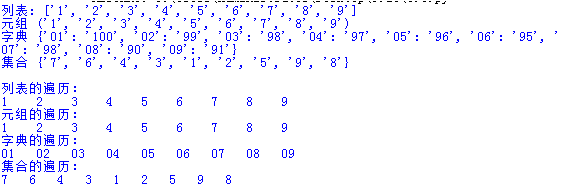组合数据类型练习,英文词频统计实例
1、列表实例:由字符串创建一个作业评分列表,做增删改查询统计遍历操作。例如,查询第一个3分的下标,统计1分的同学有多少个,3分的同学有多少个等
score = list('012332211') print('分数为:',score) print('1分的同学个数:',score.count('1')) print('3分的同学个数:',score.count('3')) print('第一个3分同学的下标为:',score.index('3')) score.append('0') print('添加一个0分在表的末尾:',score) score.insert(0,'3') print('添加一个3分在表的开头:',score) score.pop(1) print('删除第二个分数:',score)

2、字典实例:建立学生学号成绩字典,做增删改查遍历操作
d={'赵':95,'钱':86,'孙':75,'李':84,'周':96}
print('学生成绩字典',d)
d['吴']=87
print('增加一个学生')
print(d)
d.pop('孙')
print('删除学生孙')
print(d)
d['吴']=97
print('修改学生吴的成绩')
print(d)
print('查找学生赵的成绩:',d.get('赵'))

3、分别做列表,元组,字典,集合的遍历,并总结列表,元组,字典,集合的联系与区别
ls = list('123456789') ln = tuple('123456789') s = {'01':'100','02':'99','03':'98','04':'97','05':'96','05':'96','06':'95','07':'98','08':'90','09':'91'} a= set('123456789') print('列表:',ls) print('元组',ln) print('字典',s) print('集合',a) print('\n列表的遍历:') for i in ls: print(i,' ',end=' ') print('\n元组的遍历:') for j in ln: print(j,' ',end=' ') print('\n字典的遍历:') for k in s: print(k,'',end=' ') print('\n集合的遍历:') for l in a: print(l,'',end=' ')

4、英文词频统计实例
待分析字符串分解提取单词
- 待分析字符串
- 分解提取单词
- 大小写 txt.lower()
- 分隔符'.,:;?!-_’
- 计数字典
-
排除语法型词汇,代词、冠词、连词
-
- 排序list.sort()
- 输出TOP(10)
news='''It's normal for fast food brands to poke fun at their competitors, but Panera Bread's latest social media campaign isn't cracking jokes. It's a call for executives everywhere to put their kiddie meals where their mouth is. On Wednesday, Panera Bread's founder and CEO, Ron Shaich, launched the #KidsMenuChallenge, a social media campaign that challenges other fast food executives to spend a week eating the food that's served on their own children's menus.''' print('新闻:',news) news=news.lower()#小写 print('小写:',news) for i in ',.':#将符号替换成空格 news=news.replace(i,' ') print('符号换成空格:',news) words=news.split(' ')#用空格分解每一个单词 dic={}#字典 keys=set(words)#出现的所有单词的集合,字典的key exc={"a","to","is","at","the",''}#没有意义的、不要的单词 for w in exc:#去掉没有意义的单词 keys.remove(w) for i in keys:#记录次数 dic[i]=words.count(i) wc=list(dic.items())#列表 wc.sort(key=lambda x:x[1],reverse=True) print('记录次数:') for i in range(10):#显示10个单词及其次数 print(wc[i])

5、文本操作
fo=open('/Users/Administrator/Desktop/test.txt','r') news=fo.read() fo.close() exc={'the','a','to','of','and','on','in','that'} news =news.lower() for i in ''',.?!"''': news=news.replace(i,' ') print(news) words=news.split(' ') print(words) d={} keys = set(words) for r in exc: keys.remove(r) for i in keys: d[i]=words.count(i) wc=list(d.items()) wc.sort(key=lambda x:x[1],reverse=True) for i in range(10): print(wc[i])


